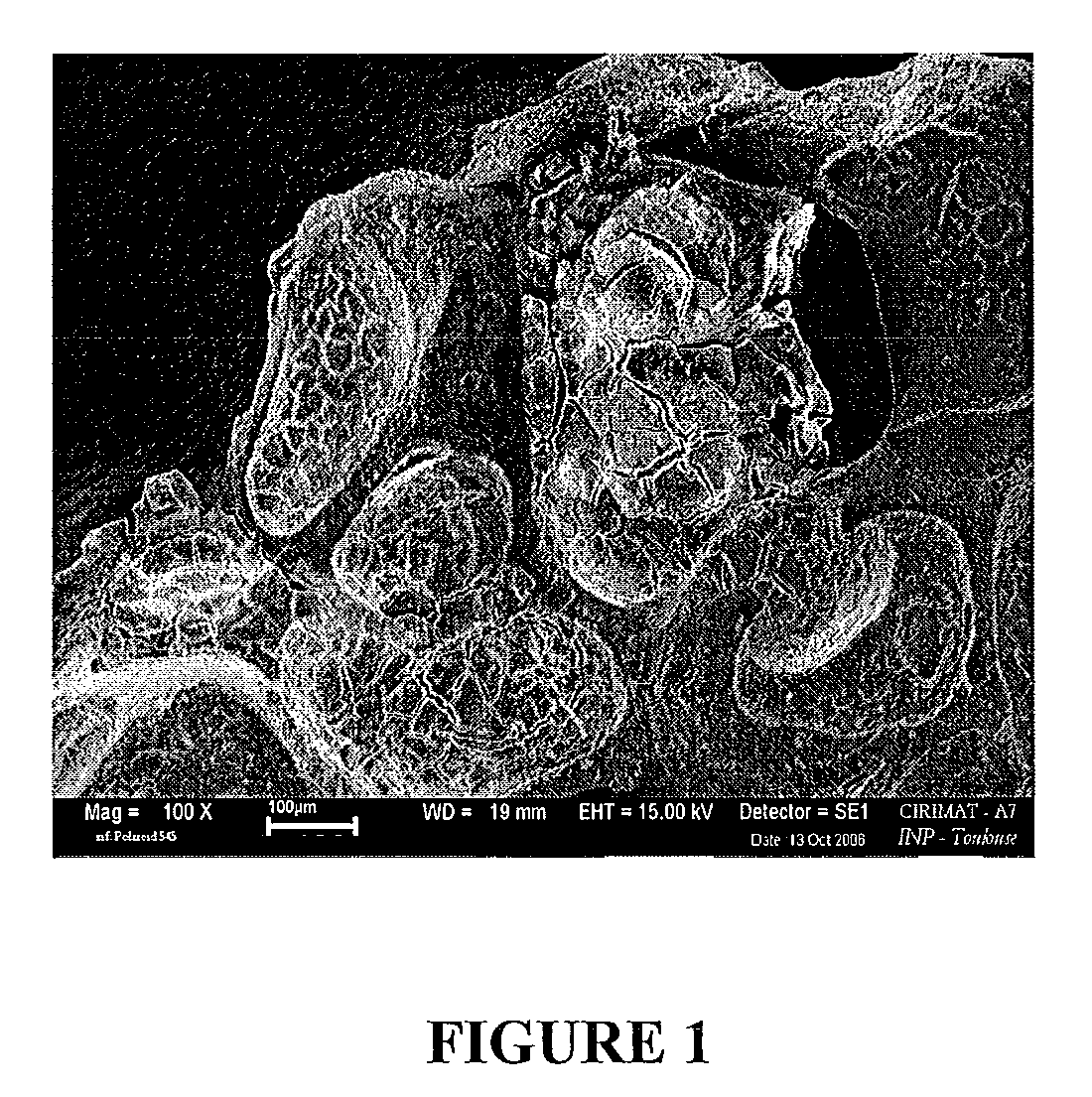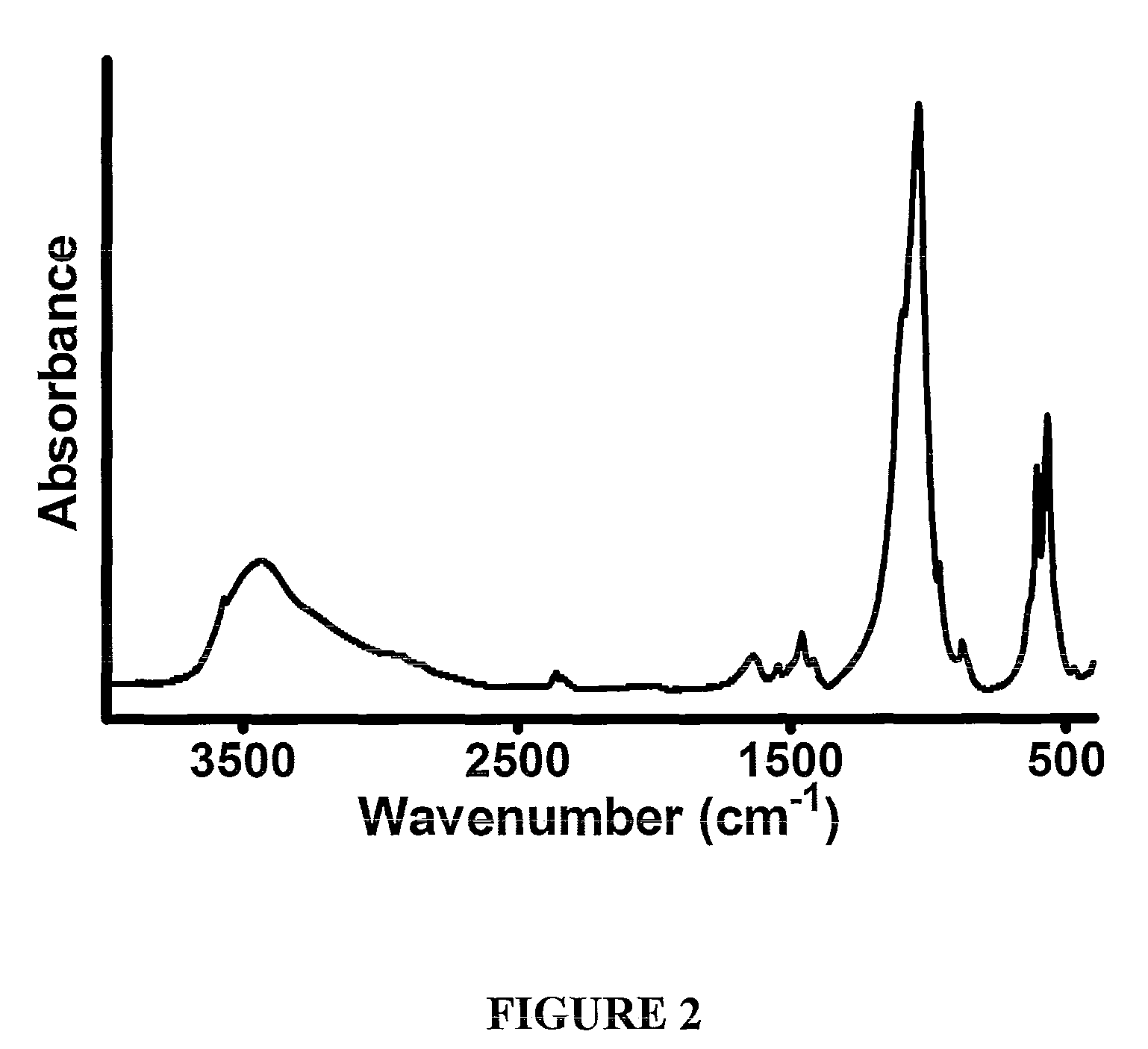Porous biomaterials surface activation method
a biomaterial and activation method technology, applied in the field of ceramic implants and orthopedic prostheses, can solve the problems of poor quality, reduced recolonization, and associated with a certain morbidity rate, and achieve the effect of facilitating associations
- Summary
- Abstract
- Description
- Claims
- Application Information
AI Technical Summary
Benefits of technology
Problems solved by technology
Method used
Image
Examples
example 1
Deposition of a Nanocrystalline Carbonated Apatite Close to Biological Apatites
[0057]Step 1: Synthesis of the carbonated apatite gel
[0058]Solution A: 48.8 g Na2HPO4.12H2O+18 g NaHCO3 in 400 ml of deionized water.
[0059]Solution B: 6.5 g CaCl2.2H2O in 150 ml of deionized water.
[0060]After complete dissolution of the salts in solutions A and B, pour solution B into solution A. Then filter and thoroughly rinse with deionized water.
[0061]Step 2: Add 50 g of gel to 200 ml of water so as to obtain a homogeneous suspension. This suspension will constitute solution C.
[0062]Step 3: A porous calcium phosphate ceramic (30 mm3 cube, 70% interconnected porosity) is immersed in solution C arranged in a vacuum flask.
[0063]A vacuum is established for around ten minutes while stirring the solution so as to eliminate any bubbles that form. Then, ambient atmospheric pressure is rapidly re-established so as to make the gel penetrate inside the pores of the ceramic. This step is repeated several times if...
example 2
Deposition of a Nanocrystalline Non-carbonated Apatite Very Rich in HPO42− Ions with a Ca / P Ratio Close to 1.35 and Having a High Proportion of Mineral Ions in the Hydrated Layer
[0070]Step 1: Synthesis of the apatite gel
[0071]Solution A: 40 g (NH4)2HPO4 in 500 ml of deionized water.
[0072]Solution B: 17.4 g Ca(NO3)2.4H2O in 250 ml of deionized water. After complete dissolution of the salts in solutions A and B, pour solution B into solution A. Then filter and thoroughly rinse with deionized water.
[0073]Step 2: Add 50 g of gel to 200 ml of water so as to obtain a homogeneous suspension. This suspension will constitute solution C.
[0074]Step 3: A porous calcium phosphate ceramic (30 mm3 cube, 70% interconnected porosity) is immersed in solution C arranged in a vacuum flask.
[0075]A vacuum is established for approximately ten minutes while stirring the solution so as to eliminate any bubbles that form. Ambient atmospheric pressure is subsequently rapidly re-established so as to make the g...
example 3
Deposition of a Nanocrystalline Carbonated Apatite with a Ca / P Ratio Close to 1.6
[0079]Step 1: Synthesis of the carbonated apatite gel
[0080]Solution A: 48.8 g Na2HPO4.12H2O+18 g NaHCO3 in 400 ml of deionized water.
[0081]Solution B: 6.5 g CaCl2.2H2O in 150 ml of deionized water.
[0082]After complete dissolution of the salts in solutions A and B, pour solution B into solution A. The suspension is left to mature for several months. Subsequently filter and thoroughly rinse with deionized water.
[0083]The other steps are identical to those of example 1.
[0084]The Ca / P ratio for these deposits (2 months' maturation) is 1.58; C / P ratio: 0.14. Crystal length: 25 nm.
PUM
| Property | Measurement | Unit |
|---|---|---|
| temperature | aaaaa | aaaaa |
| temperature | aaaaa | aaaaa |
| temperature | aaaaa | aaaaa |
Abstract
Description
Claims
Application Information
 Login to View More
Login to View More - R&D
- Intellectual Property
- Life Sciences
- Materials
- Tech Scout
- Unparalleled Data Quality
- Higher Quality Content
- 60% Fewer Hallucinations
Browse by: Latest US Patents, China's latest patents, Technical Efficacy Thesaurus, Application Domain, Technology Topic, Popular Technical Reports.
© 2025 PatSnap. All rights reserved.Legal|Privacy policy|Modern Slavery Act Transparency Statement|Sitemap|About US| Contact US: help@patsnap.com



